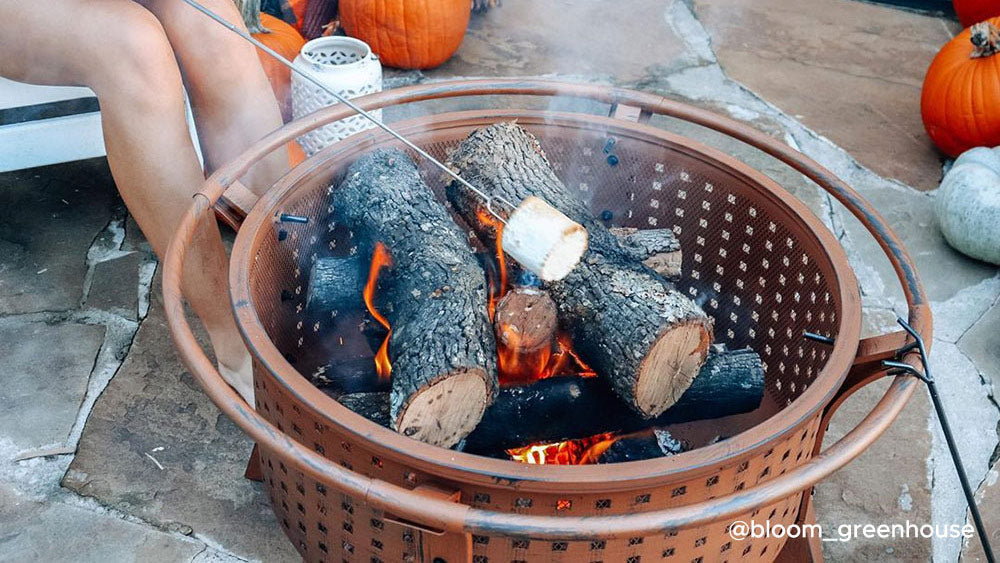Why Does Soot Build Up in Fire Pits?
Soot is a byproduct of incomplete combustion, meaning your fuel source (wood or gas) isn’t burning cleanly. The black, flaky residue sticks to metal surfaces and can be tough to remove once baked in by repeated use. Soot is more common with:
Wet or unseasoned firewood
Poor airflow in the fire pit
Infrequent cleaning
Cooking grease or debris left in the pit
Over time, this buildup can damage the finish of your outdoor fire pit and even affect performance.
Step-by-Step: How to Remove Soot Buildup
Here’s a clear and safe way to clean your fire pit:
1. Wait Until It’s Cool
Never attempt to clean a fire pit until all embers are fully extinguished and the surface is cold.
2. Remove Ash and Loose Debris
Use a scoop or metal dustpan to remove leftover ash, wood chunks, and any other debris. A fire pit cover can help reduce the amount of debris that accumulates between uses.
3. Brush Off Surface Soot
Using a stiff-bristle wire brush, scrub the interior and sides of the pit to loosen carbon residue. For gas fire pits, be gentle around burner ports and avoid damaging internal components.
4. Apply a Degreasing Cleaner
For stubborn buildup, use a mild degreasing cleaner or a paste of baking soda and water. Scrub with a non-abrasive pad.
5. Rinse and Dry
Rinse thoroughly with a hose (if your fire pit is water-safe), then dry completely to prevent rust—especially if you own a steel fire pit.
What Tools You’ll Need
Wire brush or grill brush
Soft cloth or sponge
Mild degreaser or dish soap
Baking soda (optional)
Protective gloves
Bucket of warm water
Regular upkeep makes cleaning easier and prevents long-term damage.
How to Prevent Soot Buildup in the First Place
While cleaning helps, prevention is even better. Here’s how to keep your fire pit soot-free longer:
Use Seasoned Firewood
Dry hardwood burns more completely and produces less soot in a wood burning fire pit.
Improve Airflow
Check that air vents aren’t blocked and arrange logs to allow circulation.
Avoid Cooking Directly
Grease splatters and food particles lead to faster soot accumulation. Use a fire pit grill grate for cleaner cooking.
Use a fire pit cover
Covering your fire pit between uses shields it from leaves, moisture, and debris that contribute to dirty burns.
Types of Fire Pits and Their Cleaning Needs
Not all fire pits require the same cleaning strategy. Let’s break down the differences:
Wood Burning Fire Pit
More soot, more ash—requires regular cleaning and full cool-downs.
Propane Fire Pit Table
Cleaner-burning, but burners can still accumulate carbon deposits that need gentle scrubbing.
Smokeless Fire Pits
Designed for better airflow and combustion, but still need cleaning, especially if used for cooking.
Steel Fire Pit
Durable but rust-prone—dry thoroughly after each wash and consider a high-temp paint touch-up if finish degrades.
Fire Pit Maintenance Tips for Long-Term Use
Clean every 3–5 uses to keep soot manageable.
Store with a cover to prevent moisture buildup and debris accumulation.
Inspect burner ports (if using gas) for blockages.
Avoid chemical cleaners that could release fumes the next time you light it.
Maintaining your fire pit keeps it looking good, burning efficiently, and lasting longer.
Cleaning soot buildup from your fire pit isn’t just a cosmetic issue—it’s essential maintenance. Whether you're enjoying a wood burning fire pit or a sleek propane fire pit table, regular upkeep keeps your setup safe, attractive, and functional for years to come. Use the right tools, protect with a fire pit cover, and always let the unit cool completely before scrubbing.
A clean fire pit is a high-performing fire pit—and one you’ll be proud to light up all season long.






